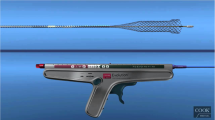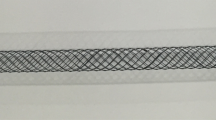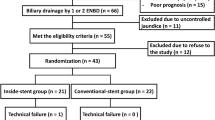Abstract
The purpose of this study was to determine the primary patency of two or more noncoaxial self-expanding metallic Wallstents (Boston Scientific, Natick, MA) and to compare this with the primary patency of a single stent in malignant bile duct obstruction. From August 2002 to August 2004, 127 patients had stents placed for malignant bile duct obstruction. Forty-five patients were treated with more than one noncoaxial self-expanding metallic stents and 82 patients had a single stent placed. Two patients in the multiple-stent group were lost to follow-up. The primary patency period was calculated from the date of stenting until the first poststenting intervention for stent occlusion, death, or the time of last documented follow-up. The patency of a single stent was significantly different from that of multiple stents (P = 0.0004). In the subset of patients with high bile duct obstruction, the patency of a single stent remained significantly different from that of multiple stents (P = 0.02). In the single-stent group, there was no difference in patency between patients with high vs. those with low bile duct obstruction (P = 0.43). The overall median patency for the multistent group and the single-stent group was 201 and 261 days, respectively. In conclusion, the patency of a single stent placed for malignant low or high bile duct obstruction is similar, and significantly longer than, that of multiple stents placed for malignant high bile duct obstruction. Given the median patency of 201 days, when indicated, percutaneous stenting of multiple bile ducts is an effective palliative measure for patients with malignant high bile duct obstruction.






Similar content being viewed by others
References
Clements WD, Diamond T, McCrory DC, Rowlands BJ (1993) Biliary drainage in obstructive jaundice: experimental and clinical aspects. Br J Surg 80(7):834–842
Kaskarelis IS, Minardos IA, Abatzis PP, Malagari KS, Vrachliotis TG, Natsika MK, Kouris SG, Roubis KG, Vrachliotis GT (1996) Percutaneous metallic self-expandable endoprostheses in bile duct obstructioncaused by metastatic cancer. Hepatogastroenterology 43(10):785–791
Lee BH, Choe DH, Lee JH, Kim KH, Chin SY (1997) Metallic stents in malignant biliary obstruction: prospective long-term clinical results. AJR 168(3):741–745
Lee MJ, Dawson SL, Mueller PR, Krebs TL, Saini S, Hahn PF (1992) Palliation of malignant bile duct obstruction with metallic biliary endoprostheses: technique, results, and complications. J Vasc Interv Radiol 3(4):665–671
Rieber A, Brambs HJ (1997) Metallic stents in malignant biliary obstruction. Cardiovasc Interv Radiol 20(1):43–49
Stoker J, Lameris JS, Jeekel J (1993) Percutaneously placed Wallstent endoprosthesis in patients with malignant distal biliary obstruction. Br J Surg 80(9):1185–1187
Adam A, Chetty N, Roddie M, Yeung E, Benjamin IS (1991) Self-expandable stainless steel endoprostheses for treatment of malignant bile duct obstruction. AJR 156(2):321–325
Kaskarelis IS, Papadaki MG, Papageorgiou GN, Limniati MD, Malliaraki NE, Piperopoulos PN (1999) Long-term follow-up in patients with malignant bile duct obstructionafter percutaneous placement of uncovered wallstent endoprostheses. Acta Radiol 40(5):528–533
Gordon RL, Ring EJ, LaBerge JM, Doherty MM (1992) Malignant biliary obstruction: treatment with expandable metallic stents—follow-up of 50 consecutive patients. Radiology 182(3):697–701
Stoker J, Lameris JS (1993) Complications of percutaneously inserted biliary Wallstents. J Vasc Interv Radiol 4(6):767–772
Boguth L, Tatalovic S, Antonucci F, Heer M, Sulser H, Zollikofer CL (1994) Malignant biliary obstruction: clinical and histopathologic correlation after treatment with self-expanding metal prostheses. Radiology 192(3):669–674
Nicholson AA, Royston CM (1993) Palliation of inoperable bile duct obstructionwith self-expanding metal endoprostheses: a review of 77 patients. Clin Radiol 47(4):245–250
Rossi P, Bezzi M, Salvatori FM, Panzetti C, Rossi M, Pavia G (1997) Clinical experience with covered wallstents for biliary malignancies: 23-month follow-up. Cardiovasc Interv Radiol 20(6):441–447
Zollikofer C (1996) Metallic stents in malignant biliary obstruction. Autopsy findings on causes of obstruction. In: Rossi P (ed) Biliary tract radiology. Springer Medica, Berlin, p 387. (chap 29)
Inal M, Akgul E, Aksungur E, Seydaoglu G (2003) Percutaneous placement of biliary metallic stents in patients with malignant hilar obstruction: unilobar versus bilobar drainage. J Vasc Interv Radiol 14(11):1409–1416
Brountzos EN, Ptochis N, Panagiotou I, Malagari K, Tzavara C, Kelekis D (2007) A survival analysis of patients with malignant biliary strictures treated by percutaneous metallic stenting. Cardiovasc Interv Radiol 30(1):66–73
Author information
Authors and Affiliations
Corresponding author
Rights and permissions
About this article
Cite this article
Maybody, M., Brown, K.T., Brody, L.A. et al. Primary Patency of Wallstents in Malignant Bile Duct Obstruction: Single vs. Two or More Noncoaxial Stents. Cardiovasc Intervent Radiol 32, 707–713 (2009). https://doi.org/10.1007/s00270-009-9577-8
Received:
Revised:
Accepted:
Published:
Issue Date:
DOI: https://doi.org/10.1007/s00270-009-9577-8




